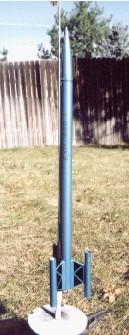| Construction Rating: | starstarstarstarstar_border |
| Flight Rating: | starstarstarstarstar_border |
| Overall Rating: | starstarstarstarstar_border |
| Manufacturer: | Mile High Rockets  |
Brief:
This is the second kit available from Mile High Rockets. It is listed as a Skill Level 3 kit and utilizes unique fin rails and a tube fin setup.
Construction:
Components are mostly high quality and include one cardboard body tube, one motor tube, three motor rings, an engine hook, plastic nose cone, 24" Kevlar cord and a 14" Kevlar wrapped shock cord, three cardboard fin tubes, three balsa fins, 9" of "easy-mount" fin rail, launch lug, decals and a 12.5" flame-resistant parachute kit (unassembled).
Instructions were comparable to Estes instructions, four pages with easy to follow illustrations. There is also an instruction sheet for the parachute kit. Assembly order was typical; not all that difficult for a Level 3 rocket. Pieces fit together well. I felt the balsa fins were of strange quality, but they sanded fine and are covered by decals in the end. I liked the balsa fin rail material which was new to me. It helped in attaching the fins to the body. I did have some trouble understanding how they were to be shaped with sandpaper, and I'm still not sure I did it right. The directions and illustrations seem to conflict in this area. I also had some trouble mounting the tube fins to the balsa fins. One needs to install all three of them at about the same time to assure vertical alignment, and this was somewhat difficult. I don't know if I like their flame-resistant parachute so I substituted a 12" mylar chute for the one provided.
Finishing:
Finishing was standard primer and paint. I used my own color selection and added only a few of the decals that were included. I didn't care for the decals much, they were a very heavy plastic and the adhesive seemed to ooze from them. After I was finished, I applied several coats of clear coat.
Construction Rating: 4 out of 5
Flight:
I have flown this only once as the body tube was severely damaged in flight and it needs repair. Preparation is typical for rockets using wadding. First flight was on an Estes A8-3. It went straight up to about 400' and landed about 100' from the pad. I would recommend a slightly longer delay.
Recovery:
The recovery system is attached to the motor mount with the two Kevlar cords. I feel that the Kevlar cord sticks way too far out of the tube and I expect the rocket to zipper before long. The directions indicate that the nose cone be attached to the middle of the elastic cord and the parachute attaches at the end. I modified this, tying the nose cone at the end and the parachute to the nose cone as I would for an Estes rocket. During the first flight, the! end of the body tube was crushed, I'm not sure if it was trying to zipper or the nose cone rebounded into it.
Flight Rating: 4 out of 5
Summary:
PROs:
- Creative styling and unique materials, mostly high quality.
- I really liked the fin rails.
CONs:
- The decals could be much better quality.
- Rocket was damaged in flight.
This is a decent second effort for Mile High Rockets. I will try them again.
Overall Rating: 4 out of 5
Other Reviews
- Mile High Rockets Explorer 1 By Layne Pemberton
Brief: Explorer 1 is a single stage, futuristically styled, sport rocket and is one of two kits available from Mile High Rockets. While rated skill level 3 by Mile High, I would put it at a solid 2. Fin tip tubes and the unique fin rail mounting system, which speeds fin attachment, add a bit of flair. The kit was supplied with: 1 plastic nose cone 1 BT-50 0.097" body tube 1 18mm ...
 |
 |
Flights
Date | Flyer | Rocket | Altitude |
|---|---|---|---|
2005-08-13 | Layne Pemberton | Mile High Rockets Explorer 1 | - |
 |
 |
Sponsored Ads
 |
 |



![Ten Miles High [Explicit] Ten Miles High [Explicit]](https://m.media-amazon.com/images/I/41gQmGSaFBL._SL500_.jpg)









J.B. (September 7, 2007)